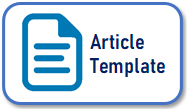Callus Regeneration of Gynura procumbens (Lour.) Merr. In Vitro
Abstract
Gynura procumbens (Lour.) Merr. is one of the species of Asteraceae which is potential as medicinal. Propagation of the species could be conducted by vegetative, so the plant genetic variability is narrow. Genetic variability could be increased by somaclonal variation through callus culture. There is no report on in vitro regeneration from callus culture, although this method could assist further genetic improvement of plants. In this experiment, different concentrations of 2,4- D (0.1 ; 0.3 ; 0.5 mg L -1 ) singly or combination with BA (0.1 ; 0.3 and 0.5 mg L -1 ) were evaluated for callus induction and several concentrations of BA (0 ; 0.1; 0.5 and 1.0 mg -1 ) combination with kinetin (0.1 and 0.3 mg-1) were observed for ability of callus formed shoots. The results showed that the best media for callus induction was 0.5 mg L -1 2,4-D + 0.5 mg L -1 BA. This treatment produced friable callus structure, no roots and yellowish white. Callus regeneration was obtained on the combination of 0.1 mg L -1 BA. + 0.1 mg L -1 kinetin and 0.1 mg L -1 BA + 0.5 mg L -1 kinetin but the percentage was still low.
Keywords: G procumbens {Lour.} Merr, induction, regeneration, calli, in vitro
Keywords
Full Text:
PDFReferences
Afandi, A., Sadikun, A., & Ismail, S. 2014. Antioxidant properties of Gynura procumbens extract and their inhibitory effects on two major human recombinant cytochrome p4508 using a high throughout luminescene assay. Asian J. Pharm. Clin. Res. 7: 36-41.
Agustina, D., Wasito, H.S., & Supatinah, A, 2006. Anticarcinogenesis effect of Gynura procumbens (Lour.)Merr. on tongue carcinogenesis in 4NQo-induced rat. Dent.J. 39: 126-132. doi:10.2174/2210315511202040247.
Bakhtiar, Z., Mirjalili, M.H., & Sonboli, A. 2016. In vitro callus induction and micropropagation of Thymus persicus (Lamiaceae). An endangered medicinal plant. Crop Breeding and Applied Biotechnology. 16(1):48-54. doi:10.1590/1984-70332016v16n1a8.
Cordeiro, S.Z., Simas, N.K., Henriques, A.B., & Sato A. 2014. Mircopropagacao e callogenesis em Mandevilla guanabarica (Apocynaceae),Uma Planta Endemica Do Brasil. Crop Breeding and Applied Biotechnology. 1492:108-115.Doi:10.1590/1984-70332014v14n2a19.
.
Gofur, A., Hamid, I.S.,& Listyorini, D. 2015. Gene p53 mutations after the induction of 7,12-Dimethyllbens(a) anthracene (DMBA) and administration of anti-carcinogenesis properties of Gynura procumbens in Sprague Dawley rats. Biomed. Engin,53-57. Available online at: http://be.ub.ac.id/index.php/jibe/article/view/17.
Hastuti,W.T.,Sari,H.I.,Wirastiti,A.,Ratnasari,& Trihantoro, S. 2013. Producing the Jelly Made of Sambung Nyawa and Stevia Leaves to Decrease the Glucose Level in the Blood. PELITA. 8 (1): 83-91.
IAEA.2010. IAEA Annual Report.2014.
Ismail, M., Bahari, E.A., Ibrahim, F.S., Dasiman R.,& Amom Z. 2016. Effets of Gynura procumbens extract on liver function test of hypercholesterolemia induced rabbits. Jurnal Teknologi. 78 (6-7):49-54. Doi:10.11113/jt.v78.9083.
Istighfari, R & Meiyanto E. 2007. Ko-Kemoterapi ekstrak etanolik daun sambung nyawa (Gynura procumbens (Lour.) Merr. dan Doxorubicin pada sel kanker payudara. Majalah Farmasi Indonesia. 18)20:81-87.
Kaewseejan,N.,Sutthikhum,V.,&Siriamornpun S. 2015. Potential of Gynura procumbens leaves as source of flavonoid-enriched fractions with enhanced antioxidant capacity. Journal of Funtional Foods. 12:120-128.
Mahmood,.AA., Abdalbasit, A.M., Fouad, A.B.,& Siddig, I.A.W. 2010. Anti-ulcerogenic activity of Gynura procumbens leaf extract against experimentally-induced gastric lesions in rats. Journal of Medicinal Plants Research. 4(8):685-691.
Malik, S.I., Rasyid, H., Yasmin, T., & Minhas, M.N. 2004. Effect of 2,4-dichlorophenoxyacetic Acid on Callus Induction from Mature Wheat (Triticum aestivum L.) Seeds. Inter. J. of Agricultural and Biology. 6(1): 156-159.
Mokhtari A., Otroshy, M., Barekat, T. 2015. Plant regeneration through callus induction on medicinal herb Viola odorata-role of plant growth regulator and explants. Agr.Forest.61:161-170.
Nurokhman A, Faizah, A., Sugiharto., Utami, E.S.W.,Manuhara,Y.S.W. 2019. Effect of plant growth regulators and explants types on in vitro callus induction of Gynura procumbens (Lour.) Merr. Research Journal of Biotechnology.14(9):102-107.
Rostiana, O dan Syahid, S.F. 2008. Somatic embryogenesis from meristem explants of ginger. Biotropia. 15(1): 12-24.
Suhatri S., Adhliany, S., Aria, M. 2019. Scientia. 9(1):109-115.
Zamini A., Mokhtari., Tansaz., Zarei, M. 2016. Callus induction and plant regeneration of Valeriana officinalis are affected by different leaf explants and various concentrations of plant growth regulators. BioTechnologia. 97(4);261-269.
Refbacks
- There are currently no refbacks.




